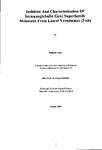Isolation And Characterisation Of Immunoglobulin Gene Superfamily Molecules From Lower Vertebrates (Fish)
| dc.contributor.author | Yang, Bingmei | |
| dc.contributor.other | Faculty of Health | en_US |
| dc.date.accessioned | 2013-10-21T09:29:11Z | |
| dc.date.available | 2013-10-21T09:29:11Z | |
| dc.date.issued | 1998 | |
| dc.identifier | NOT AVAILABLE | en_US |
| dc.identifier.uri | http://hdl.handle.net/10026.1/2236 | |
| dc.description.abstract |
Acquired immunity in vertebrates is a major mechanism of the immune system, which enables the vertebrates to discriminate self and non-self The most important feature of acquired immunity is the major histocompatibility complex (MHC) restricted-cellular immune response. This involves several important elements including MHC molecules and T cell antigen receptor (TCR) complex. MHC molecules are glycoproteins that recognise and present self and foreign peptides to T-cells via the TCR, causing the T cell to proliferate and secrete cytokines. There is increasing evidence that peripheral T cells and MHC restricted cellular immune responses occur in all vertebrates. However, the exact nature of the TCR and MHC in lower vertebrates has still to be established. The aim of this thesis was firstly, to use the polymerase chain reaction (PCR) in conjunction with degenerative primers to the TCR β chain variable region (TCRBV) sequences of the homed shark to allow the amplification of the TCR-like genes from dogfish, Scyliorhinus canicula; secondly, to employ a similar strategy using degenerative primers to the banded houndshark MHC class-I α3 DNA sequence, to amplify MHC genes from S. canicula. Using the degenerative primers, four clones from dogfish genomic DNA were obtained. These clones showed homology to TCR genes of other species. The amino acid sequence of clone 2C144 showed homology to the TCRBV region of several species. The highest similarities include 51.7% with the honed shark TCRBV, 45.1% with human TCRBV, 41% with monkey TCRBV, 40.7% with bovine TCRBV and 38.8 and 37.5% with chimpanzee and rat TCRBV, respectively. The clone 6C43 also showed homology to the TCRBV genes of several species (similarity is between 21.1% to 23.9%). Another two clones (6C53 and 6C54) were identified that showed high homology to the TCR δ chain variable region (TCRDV) of other vertebrates with 45.7% identity to the honed shark TCRDV region, 43.2% identity to mouse TCRDV, 32.2% identity to porcine TCRDV region, and 30.7% identity to human TCRDV. The highly conserved residues in the other vertebrates TCR are present in these four clones as well, such as WYRQ37 and YY(F)C92 motifs. Southern blotting analysis with the putative TCRBV (2Cl44) and TCRDV (6C53 and 6C54) suggested that polymorphism existed between different fish. Northern blotting analysis with the probe 6C53 identified a transcript of approximately 2 kb in the spleen., lymphocytes and brain as well, with the probe 2C144 identified a transcript of approximately 2 kb in the lymphocytes of dogfish. The sequences of nine clones obtained using cDNA as a template from dogfish together with degenerative primers showed high homology to the membrane-proximal domain of the MHC class II α chain in several species. These clones exhibited a high degree of homology to the nurse shark MHC class II α chain (74.1%), zebrafish MHC class II α chain (52.8%), mouse MHC class II I-A (49.6%), rat MHC class II α chain (49.9%), bovine MHC class II DYα chain and DQα chain (52.7% and 44.9%, respectively), human HLA- DP, - DQα and -DRα chain (44.4%) respectively. The cysteine residues of the membrane-proximal domain are conserved in the dogfish, suggesting that it may have a similar tertiary structure to mammalian MHC class II proteins. A highly conserved tryptophan residue at position 121 was found in the dogfish and an N-linked glycosylation site was present at position 133, whilst in higher mammals it is usually found at position 118. The Southern blotting analysis using probe DM9 showed that there may be more than four loci of MHC class IIA in dogfish. These results suggest that the MHC class II, TCRB and TCRD genes are present in dogfish. The dogfish may have distinct T-cells, expressing either αlβ or γ/δ heterodimers. Conserved key residues in both MHC class IIA. TCRB and TCRD suggest that these genes may encode functional MHC class II, TCRB and TCRD molecules. The MHC restricted cellular immune response may be present in dogfish. Dogfish TCRB, TCRD and MHC class II genes show high homology with several species including human, rat, bovine and other fish species, which implies that the immunoglobulin (Ig) superfamily has evolved from a common ancestor. | en_US |
| dc.language.iso | en | en_US |
| dc.publisher | University of Plymouth | en_US |
| dc.title | Isolation And Characterisation Of Immunoglobulin Gene Superfamily Molecules From Lower Vertebrates (Fish) | en_US |
| dc.type | Thesis | |
| dc.identifier.doi | http://dx.doi.org/10.24382/1425 |
Files in this item
This item appears in the following Collection(s)
-
01 Research Theses Main Collection
Research Theses Main


